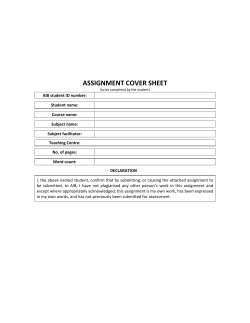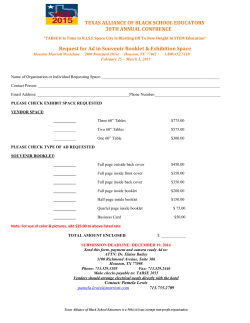
324KB - NZQA
91094 1 910940 SUPERVISOR’S USE ONLY Level 1 Music, 2014 91094 Demonstrate knowledge of conventions used in music scores 2.00 pm Wednesday 26 November 2014 Credits: Four Achievement Demonstrate knowledge of conventions used in music scores. Achievement with Merit Demonstrate in-depth knowledge of conventions used in music scores. Achievement with Excellence Demonstrate comprehensive knowledge of conventions used in music scores. Check that the National Student Number (NSN) on your admission slip is the same as the number at the top of this page. You should attempt ALL the questions in this booklet. Pull out Resource Booklet 91094R from the centre of this booklet. If you need more room for any answer, use the extra space provided at the back of this booklet. Check that this booklet has pages 2 –11 in the correct order and that none of these pages is blank. YOU MUST HAND THIS BOOKLET TO THE SUPERVISOR AT THE END OF THE EXAMINATION. TOTAL ASSESSOR’S USE ONLY © New Zealand Qualifications Authority, 2014. All rights reserved. No part of this publication may be reproduced by any means without the prior permission of the New Zealand Qualifications Authority. 2 QUESTION ONE ASSESSOR’S USE ONLY Refer to Score Extract A, from “The Moon is Distant from the Sea”, on pages 2 and 3 of the resource booklet to answer this question. (a) (b) (c) (d) (i) What time signature should be written for bars 35 – 45? (ii) Identify a bar in which the music slows down. (i) Explain why the instruction “a tempo” is needed in bar 37. (ii) Identify the minimum number of singers required to perform this extract. (i) Explain why the marking “8va” is used in the piano part in bar 39. (ii) Explain how the pianist would perform the highlighted part in bar 49. Identify the texture of the music in the following bars (eg “monophonic”), and provide ONE piece of musical evidence to support each answer. Bar 37 Texture: Bar 44 Texture: Bar 48 Texture: Music 91094, 2014 3 (e) Identify, in the soprano part, ONE example of a melisma used in the word-setting. Copy the melisma onto the staff below, including the lyrics. Soprano (f) ## & The extract is in the key of B minor from bar 37 until it briefly modulates to another key. (i) Identify the bar in which the modulation occurs. (ii) Identify the new key. (iii) Identify the relationship of the new key to the tonic key of B minor (eg “relative major”). (g) Describe the intervals bracketed and labelled (1) – (3) in bars 41– 43. State both the quality and quantity of the interval (eg “perfect octave”). Interval no. Interval (1) (2) (3) (h) Provide TWO pieces of musical evidence to explain why the beginning of bar 44 is the climax point of this extract. (1) (2) Music 91094, 2014 ASSESSOR’S USE ONLY 4 QUESTION TWO ASSESSOR’S USE ONLY Refer to Score Extract B, from “Blue Suede Shoes”, on pages 4 and 5 of the resource booklet to answer this question. (a) The vocal melody is based mainly on the repetition of the two-bar phrase highlighted in bars 61– 62. Describe TWO different ways that this phrase is varied to create interest. For each response, identify the bar number, and the musical element that is varied (eg “harmony”). (1) Bar no.: Element: (2) Bar no.: Element: (b) Describe how the notes in the guitar part in bars 64 – 69 relate to the harmony. (c) The guitarist plays a ‘lick’ in bar 59 and bars 71–72 (both highlighted on the score). Describe ONE similarity and TWO differences when it is played for the second time. For each response, identify the musical element that is similar or different (eg “harmony”). Element: Similarity: Element: Difference: Element: Difference: Music 91094, 2014 5 (d) Identify an example of the following guitar techniques in the solo (bars 48 – 59). For each: • give the bar number • copy the notation onto the guitar tablature staff • explain how it would be played. Technique Whole-step bend Legato slide Notation ⁄ ⁄ ⁄ Pull-off (e) Bar no. - How it is played - (i) Identify the key of the extract. (ii) On the staff below, notate: • the key signature of this key. • one octave of the scale of this key, ascending, in semibreves. & - (iii) Identify TWO different notes in the vocal part which are not in this scale. For each, state: • the bar number • the word on which the note is sung • the degree of the scale which has been changed (eg “tonic”). Bar no. Word Scale degree (iv) What is the musical term, in this style of music, for the notes that do not belong to the scale? Music 91094, 2014 ASSESSOR’S USE ONLY 6 (f) Identify the THREE different chords which are used in the harmony of the extract. For each: • write the jazz / rock chord symbol in the box above the staff • notate the chord as a triad in root position, including any necessary accidentals (do NOT write in the key signature). - & (g) (i) & & What part of the song are bars 60 –72 from? Provide TWO pieces of musical evidence to support your answer. Part of the song: (1) (2) (ii) What is the form of this song? Provide ONE piece of musical evidence to support your answer. Form: Music 91094, 2014 ASSESSOR’S USE ONLY 7 QUESTION THREE ASSESSOR’S USE ONLY Refer to Score Extract C, from “Especially for You”, on pages 6 and 7 of the resource booklet to answer this question. (a) (i) What type of ensemble is this music written for? (ii) List ALL the non-transposing melodic instruments. (iii) Explain what the instruction “a2” means in the clarinet part in bar 1. (b) Identify the TWO percussion instruments that are likely to play in this extract, and provide ONE piece of different musical evidence to support each answer. Instrument (1): Instrument (2): (c) (d) (i) Suggest an Italian word for the initial tempo of this piece. (ii) What is the name given to the marking “ A” (bar 9)? Identify the highest and lowest pitches played in the extract, and the instrument that plays each. Pitch name Instrument Highest pitch Lowest pitch Music 91094, 2014 8 (e) Rewrite bars 13 –16 of the cornet part so that each player’s music is on a single staff. Include all performance markings for each part. ° ˙ œœ œœ ˙ ¢& ˙˙ #œœ œœ ˙˙ ##˙˙˙ - Cornets I.II.III. f Cornet I ° & Cornet II & Cornet III ¢& U œœ œ œœœ œ ˙˙˙ #˙˙˙ œ rit. 13 nn˙˙˙ (f) Identify the compositional device used in the flute part in bars 5 – 8. (g) The mood of the music changes at the Andante beginning at bar 17. (i) Describe how the tuba part has changed in the Andante section. (ii) Describe how the rhythm of the horn part is different in bars 19 –24, compared to bars 9 –14 (highlighted in the score). (iii) What is the musical term for this compositional device? Music 91094, 2014 ASSESSOR’S USE ONLY 9 (h) Transpose the clarinet part from bars 18 – 22 down a tone into concert pitch. Include: • the key signature • performance markings • any necessary accidentals. ∑ Clarinets I.II. in Bb B ˙ œœœ ˙ ˙ Ó Œ œ & œ 18 a2 mp Clarinets I.II. (concert pitch) & Music 91094, 2014 ˙ #œ œ œ œ ˙ ˙ ASSESSOR’S USE ONLY 10 QUESTION NUMBER Extra space if required. Write the question number(s) if applicable. Music 91094, 2014 ASSESSOR’S USE ONLY 11 QUESTION NUMBER Extra space if required. Write the question number(s) if applicable. Music 91094, 2014 ASSESSOR’S USE ONLY 91094
© Copyright 2025









